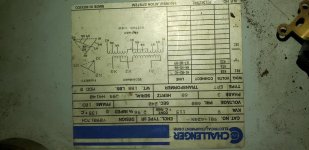m-lud
Stainless
- Joined
- Sep 4, 2016
The tag below is on a transformer available for purchase. I think it may be too small for my purpose. My only 480 machine is a Fosdick jig bore. I'm not sure what the amperage is on the jig bore motors. I cant get that information today. I don't think any of the motors are over 3hp.
I have had the jig bore for years. I know jig bores are obsolete. Its only reason for not being up and running is it's 480 voltage.
What I'm looking for is what amperage output I could expect out of this transformer reverse feeding It ?
Ill be feeding it with a 10 h.p. RPC with line voltage 120/120/105. The 105 being the manufactured leg.
I also remember there can be a voltage spike at start up when reverse feeding.
What do you do about that ?
Is tis t the wrong transformer?
Sorry about the photo rotation

don't click the attachment
View attachment 299556
I have had the jig bore for years. I know jig bores are obsolete. Its only reason for not being up and running is it's 480 voltage.
What I'm looking for is what amperage output I could expect out of this transformer reverse feeding It ?
Ill be feeding it with a 10 h.p. RPC with line voltage 120/120/105. The 105 being the manufactured leg.
I also remember there can be a voltage spike at start up when reverse feeding.
What do you do about that ?
Is tis t the wrong transformer?
Sorry about the photo rotation

don't click the attachment
View attachment 299556

